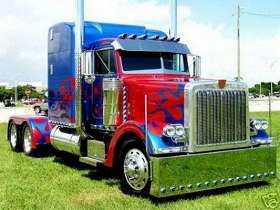What Are Your Opinions On Floating Gears?
Topic 12926 | Page 2
Using a clutch (required by school and DOT examiners) releases stress between the gears.
Floating gears requires you to have good timing in moving the stick, and good control of the accelerator pedal. Not that easy for newbies.
Floating gears and forcing gears together makes the grinding, and the grinding means the transmission is getting damaged. (Not to worry, it takes lots and lots of grinding to really mess it up.)
Whether you're a new driver or have several years' experience, you'll occasionally grind some. After you get your own truck, just try to do it right, and don't worry about it.
Floating Gears:
An expression used to describe someone who is shifting gears without using the clutch at all. Drivers are taught to "Double Clutch" or press and release the clutch twice for each gear shift. If you're floating gears it means you're simply shifting without using the clutch at all.
DOT:
Department Of Transportation
A department of the federal executive branch responsible for the national highways and for railroad and airline safety. It also manages Amtrak, the national railroad system, and the Coast Guard.
State and Federal DOT Officers are responsible for commercial vehicle enforcement. "The truck police" you could call them.
Even with a clutch - if you don't match engine/transmission/road speed - you WILL GRIND GEARS.
The fact that you need to double clutch for your road test (DMV), means you should learn how to DC. It becomes a matter of timing/muscle memory.
I started floating in school - and by the time I road tested, I couldn't DC to save my life - failed my first road test on MISSED SHIFTS (24 to be exact - no points deducted for ANYTHING ELSE).
So resist the temptation to float, until you get out on the road.
All things being equal - I shift much more smoothly floating gears , than DC'ing. Once you learn not to force things - they just drop right in like buttah.
BUT - if you're in training, you do as the INSTRUCTOR INSTRUCTS - lest you find yourself on the greydog home.
Rick
Floating Gears:
An expression used to describe someone who is shifting gears without using the clutch at all. Drivers are taught to "Double Clutch" or press and release the clutch twice for each gear shift. If you're floating gears it means you're simply shifting without using the clutch at all.
Double Clutch:
To engage and then disengage the clutch twice for every gear change.
When double clutching you will push in the clutch, take the gearshift out of gear, release the clutch, press the clutch in again, shift the gearshift into the next gear, then release the clutch.
This is done on standard transmissions which do not have synchronizers in them, like those found in almost all Class A trucks.
Dm:
Dispatcher, Fleet Manager, Driver Manager
The primary person a driver communicates with at his/her company. A dispatcher can play many roles, depending on the company's structure. Dispatchers may assign freight, file requests for home time, relay messages between the driver and management, inform customer service of any delays, change appointment times, and report information to the load planners.DMV:
Department of Motor Vehicles, Bureau of Motor Vehicles
The state agency that handles everything related to your driver's licences, including testing, issuance, transfers, and revocation.

Eaton-Fuller representative came and showed gears out of transmissions. The floated gears were worse that the double clutched. Eaton-Fuller recommends double clutching , as does most schools, and many companies. If I was an O/O and it was MY transmission I would follow the manufacturers advice. Just my opinion, and many will differ.
Double Clutch:
To engage and then disengage the clutch twice for every gear change.
When double clutching you will push in the clutch, take the gearshift out of gear, release the clutch, press the clutch in again, shift the gearshift into the next gear, then release the clutch.
This is done on standard transmissions which do not have synchronizers in them, like those found in almost all Class A trucks.
Double Clutching:
To engage and then disengage the clutch twice for every gear change.
When double clutching you will push in the clutch, take the gearshift out of gear, release the clutch, press the clutch in again, shift the gearshift into the next gear, then release the clutch.
This is done on standard transmissions which do not have synchronizers in them, like those found in almost all Class A trucks.
And I'm sure he brought in the "worst case" scenario parts too lol Working on Class 8 trucks, I never seen a trans go bad from floating gears. You gotta be a real idiot and do it over a long period of time, constantly grinding gears. Usually, even then the brass synchros wear way before the steel gears ever do.....I float gears in my VW's and motorcycles all the time, and they aren't built as tough as an Eaton Fuller is lol
Floating Gears:
An expression used to describe someone who is shifting gears without using the clutch at all. Drivers are taught to "Double Clutch" or press and release the clutch twice for each gear shift. If you're floating gears it means you're simply shifting without using the clutch at all.
Float Gears:
An expression used to describe someone who is shifting gears without using the clutch at all. Drivers are taught to "Double Clutch" or press and release the clutch twice for each gear shift. If you're floating gears it means you're simply shifting without using the clutch at all.
Grinding gears is what wears the gear teeth out. Double clutching does absolutely nothing to prevent gears from grinding, nor does floating gears cause them to grind. Trying to put the transmission in gear without the transmission speed, road speed, and RPM's being matched up properly is what causes gears to grind and they'll grind just the same whether or not you have the clutch pushed in.
The idea that double clutching prevents the gears from wearing out prematurely is simply not true. How well you shift into gear without grinding the gears will determine how long the teeth will last regardless of what you do with the clutch.
Floating Gears:
An expression used to describe someone who is shifting gears without using the clutch at all. Drivers are taught to "Double Clutch" or press and release the clutch twice for each gear shift. If you're floating gears it means you're simply shifting without using the clutch at all.
Double Clutch:
To engage and then disengage the clutch twice for every gear change.
When double clutching you will push in the clutch, take the gearshift out of gear, release the clutch, press the clutch in again, shift the gearshift into the next gear, then release the clutch.
This is done on standard transmissions which do not have synchronizers in them, like those found in almost all Class A trucks.
Double Clutching:
To engage and then disengage the clutch twice for every gear change.
When double clutching you will push in the clutch, take the gearshift out of gear, release the clutch, press the clutch in again, shift the gearshift into the next gear, then release the clutch.
This is done on standard transmissions which do not have synchronizers in them, like those found in almost all Class A trucks.

Correct. The gears in a semi are cut differently and non synchronized...YOU as the driver are the synchronizer. Bigger companies don't want you to openly float because they don't want you learning to float on their equipment and tearing it up. Guarantee you they aren't giving the experienced driver any grief over it. Why? He's not grinding and jamming the gears. I agree those gears were probably 'worst case scenario' kinds of gears, and the fact is you don't know who drove it and how its entire life. All things equal, two trucks driven a lifetime with never grinding gears at all, one DC and one floated, the one DC will have accelerated wear. Why? More clutch and linkage/cable wear.
Don't be too quick to believe what you are told. As with many things in this country, people are led in a certain direction by controlled use of information.
HOS:
Hours Of Service
HOS refers to the logbook hours of service regulations.
Thanks everyone for your advice. greatly appreciated.
New Reply:
New! Check out our help videos for a better understanding of our forum features

















Preview:
This topic has the following tags:
Advice For New Truck Drivers Automatic Transmissions Becoming A Truck Driver Getting Your CDL Truck Driver Training Truck Equipment







 TT On Facebook
TT On Facebook
One reason they do not want you to float gears , is because some instructors who will test you for your license will not pass you if you do not double clutch. It's best to know how to double clutch , and then later on floating gears is something you will do because it just makes the process simpler once your brain gets dialed in and learns when to shift.
Floating Gears:
An expression used to describe someone who is shifting gears without using the clutch at all. Drivers are taught to "Double Clutch" or press and release the clutch twice for each gear shift. If you're floating gears it means you're simply shifting without using the clutch at all.
Float Gears:
An expression used to describe someone who is shifting gears without using the clutch at all. Drivers are taught to "Double Clutch" or press and release the clutch twice for each gear shift. If you're floating gears it means you're simply shifting without using the clutch at all.
Double Clutch:
To engage and then disengage the clutch twice for every gear change.
When double clutching you will push in the clutch, take the gearshift out of gear, release the clutch, press the clutch in again, shift the gearshift into the next gear, then release the clutch.
This is done on standard transmissions which do not have synchronizers in them, like those found in almost all Class A trucks.